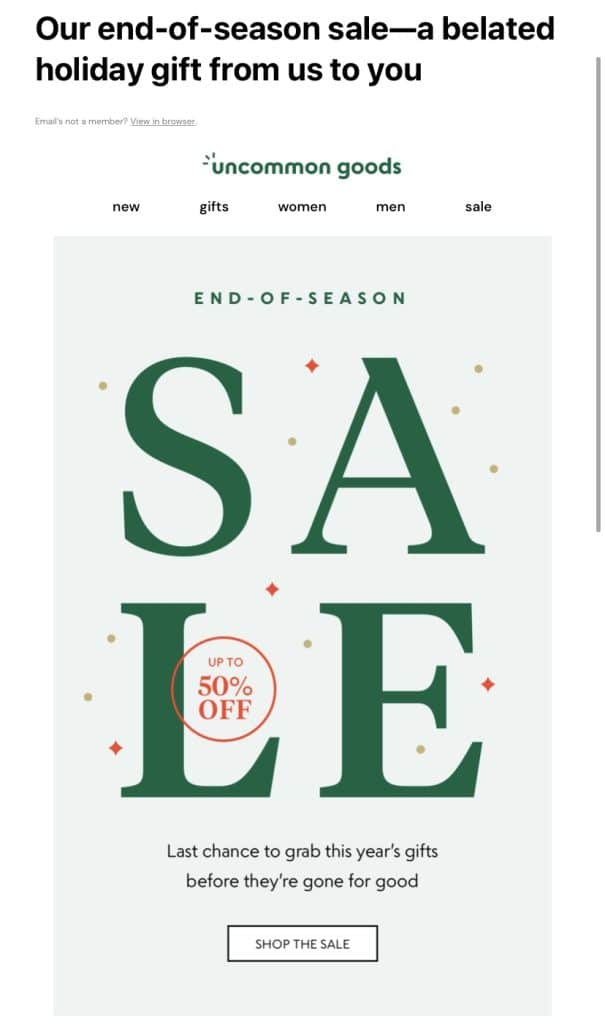After the hustle and bustle of the holiday season, the first few months of the new year can be a challenging time for retail marketers. You’ve just spent significant time and effort getting customers to buy, and hopefully your strategies have paid off with strong sales. But now what? On the heels of such a promotion-saturated season, boosting immediate sales should not be your top priority. Instead, it’s the perfect time to focus your marketing efforts on building brand awareness and bringing in new customers — particularly those shoppers that didn’t buy during the holiday rush.
Here are some essential post-holiday marketing strategies to help you avoid a sales slump and start the new year right.
1. Retarget, Retarget, Retarget
Retargeting is a popular marketing tactic that serves targeted ads to consumers based on their past behavior on your website. If one of your visitors abandons an item in their shopping cart, for example, they’ll see that item again in a targeted Google ad and be reminded to buy. Or they may be served a Facebook ad for an item they viewed but did not purchase.
While retargeting is a useful strategy any time of year, it’s especially helpful after the holidays. You most likely had a surge of shoppers browse your site without buying, and retargeting can help recover these missed sales opportunities. Even better, you can retarget shoppers you lost as a result of 2021’s supply chain and shipping crisis by alerting them to available items they may have passed on because they were out of stock or had shipping delays.

Over 25% of consumers say they appreciate being reminded of products they’ve previously pursued. -Skai¹
2. Concentrate on Cross-Selling & Relationship Building
Cross-selling is another great strategy for holding the interest of your holiday audience. It can be particularly effective for converting one-time holiday shoppers into repeat customers, which is a post-season sales opportunity you don’t want to miss. That’s because a customer has a 27% chance of returning to your store after making one purchase. Get them to come back and buy a second and third time, and they have a 54% chance of returning to make yet another purchase.
So whether it’s a set of coffee mugs to go along with the bean grinder they bought or a pair of sneakers to complement their new workout gear, promoting related products to first-time buyers after the holidays can make a big impact on your bottom line.
You can also use this time to further nurture your relationship with these new holiday shoppers by creating email campaigns that feature:
- Post-purchase discounts, loyalty points, and other rewards
- Information, advice, and pointers on how to use your products
- Monthly newsletters with links to blog posts and other website content
- Exclusive access to upcoming promotions and/or new products

3. Dig Deep Into Your Data
Of course, to cross-sell and retarget effectively you need to understand the behavior of the people who interacted with your site. Now’s the time to really focus on mining your customer data for key insights to help inform your post-holiday campaigns.
For example, you can use your holiday sales analytics to determine which products were most popular and should be used as a basis for cross-selling related items. Or you can review the performance of your holiday email campaigns to get a sense of what types of promotions were most successful. Reviewing metrics like open rates, click-through rates, and campaign conversion stats can help you understand what types of messaging inspired the most engagement and led to sales.
And if you’re not already optimizing your customer data with a real-time data and insights strategy, now’s the time to get started. In addition to helping you develop the most accurate and up-to-date post-holiday marketing campaigns, having instant access to key insights means you can make data-informed adjustments to improve the performance of these campaigns while they are still in flight.
4. Keep Running Promotions
After taking advantage of discounts and deals for more than two months, going right back to full price may be a system shock for some shoppers. And there are still plenty of post-holiday shoppers out there — in addition to those looking to buy items they couldn’t get back in December due to supply chain-related delays, there are customers eager to use the gift cards they received as presents. In fact, when asked what their main motive was for post-holiday shopping, 57% of consumers said capitalizing on discounts, while 38% said shopping for themselves.

So while you certainly don’t have to keep running the same discounts and deals from holiday 2021, you should feature other promotions to remain top-of-mind and help ease your customers into the new year. If you’re unable to mark down prices, you can offer other incentives such as free shipping, complimentary products, buy-one-get-one-free, and rewards points. Establishing loyalty programs and awarding members with perks can be especially effective when it comes to building a core customer base and elevating brand awareness and reputation.
75% of consumers say they are likely to make another purchase after receiving an incentive. -Wirecard
Focus Your Post-Holiday Campaigns on Pulling in New Customers
Marketing to retail customers right after a promotion-heavy holiday season can be tricky. Instead of worrying about raising immediate sales — which will be a daunting task if your campaigns were successful — now’s the ideal time to focus your efforts on bringing in new customers and further engaging the ones you’ve gained. If you are diligent about diving deep into the consumer data you’ve collected, you should be able to create effective retargeting and upselling campaigns. It also pays to run other promotions and lean on loyalty programs to remain competitive and keep your brand top-of-mind.
Facebook
Twitter
LinkedIn








